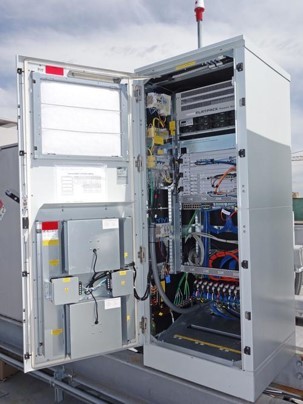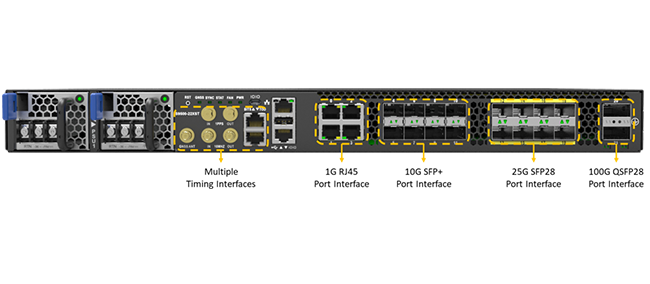[英文] Everything You Need to Know About DCSG
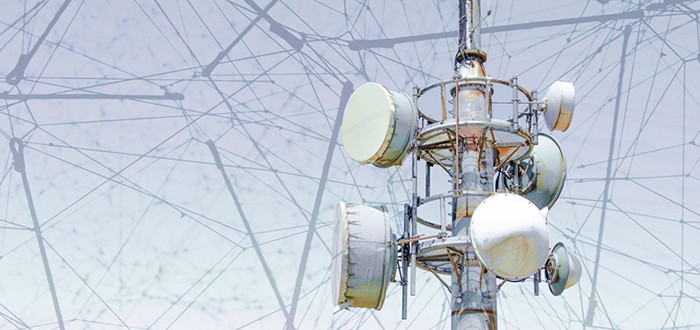
The disaggregated cell site gateway (DCSG) is a solution many service providers are deploying at their cell sites to perform multi-function backhauling. The DCSG combines the benefits from a versatile white box platform with an open networking ecosystem of developers to create its service features.
This ultimate guide will tell you everything you need to know about disaggregated cell site gateways.
What is a cell site gateway?
2. What is a DCSG?
3. DCSG Benefits for Telecom
4. Why Start with DCSG?
5. History of DCSG
6. DCSG Hardware Features
7. DCSG Software Features
8. DCSG Use Cases
9. Where to Find DCSGs
10. What are the DCSG Options?
What is a Cell Site Gateway?
A cell site gateway, or cell site router, is a L2/L3 device that aggregates mobile data traffic from the cellular access network (cell sites) and transports it back to the service provider’s core network. This makes the cell site router a component of the telecommunication backhaul network.
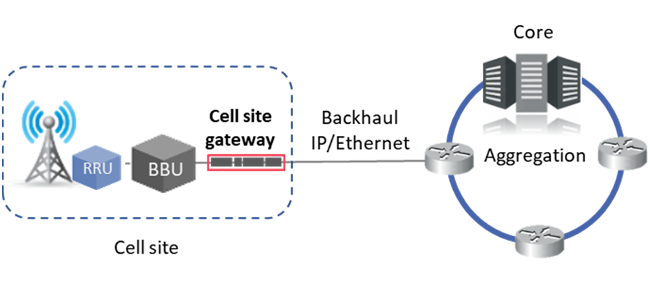
Cell Site Gateway position within the transport network
Aggregating data from cell sites means that a modern day cell site router would be able to accommodate 2G/3G/4G cellular technologies with various features to support QoE including time synchronization, connectivity, and routing protocols.
As mentioned before, cell site routers are equipment mainly used by telecommunications service providers. The physical placement of the cell site router is typically in an outdoor cabinet or in a room located at the cell site base station owned by the service provider, and very likely within arm’s reach of the base band unit.
Data Centers and cloud will play a big role in the digital transformation with 5G. Service delivery will depend heavily on edge cloud processing and cloud interconnect services. UfiSpace and Arrcus participated in several interoperability tests cases for Ethernet VPN (EVPN) and IPVPN including support for Carrier Ethernet services providing E-Line services, Integrated Routing and Bridging (IRB) functions enabling EVPN extension between subnets, and MAC Mobility within SR-MPLS.
What is a DCSG?
The DCSG, or Disaggregated Cell Site Gateway, is an open network cell site router that has decoupled its software features from its hardware components. The cell site router is built as a white box platform using merchant silicon, with the capability to integrate network operating systems from different solution providers using standardized APIs.
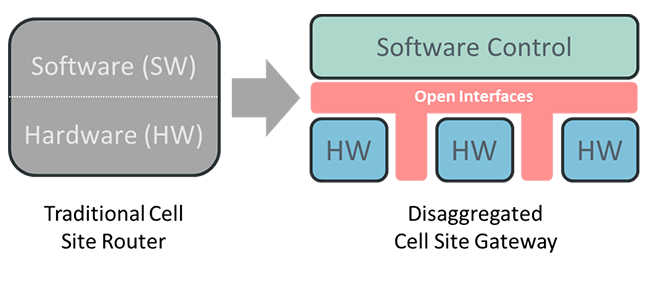
Traditional cell site router vs disaggregated cell site gateway
The DCSG opens the door for any developer to build their solution on top of the platform and enter the backhaul market. This spurs rapid innovation and introduces more vendors who can potentially provide new and improved solutions for service providers.
DCSG Benefits for Telecom?
The DCSG (Disaggregated Cell Site Gateway), is a solution to allow telecommunication service providers deploy 5G networks efficiently and economically by removing barriers such as:
• Lack of hardware and software selection available to foster innovation
• Limited interoperability to enable multi-vendor environments
• Unreasonable licensing practices for multi-vendor integration
• Limited availability of choice from proprietary solutions
These were the problems faced by service providers when they were deploying cell site routers in their mobile networks during 2G, 3G and 4G deployments.
Why Start from DCSG?
There are many parts of the network to deploy disaggregated and open network solutions, but many service providers are starting with the DCSG. The reason why service providers are starting from DCSG is because the cell site is the simplest and fastest way to realize return on investment (ROI).
Here are some reasons why service providers are starting with DCSG:
• Traffic pattern is simpler than other parts of network
• They can upgrade piecemeal and minimize disruption to other parts of carrier’s network
• Easy to start with minimal investment
• Enable access network to meet the stringent timing requirement of 5G RAN
• Prepare backhaul capacity for the surge of future traffic volumes
Service providers who are unfamiliar with disaggregated and open networking solutions can utilize the DCSG as a way to better understand the implementation and maintenance processes.
History of DCSG
The earliest known concept of a disaggregated cell site gateway router was introduced by AT&T in 2017 when they began conducting trials for introducing a telecom white box into their network. At the time they were collaborating with Intel and Broadcom and working with Linux based operating systems. AT&T was developing it as a white box cell site gateway router (CSGR). Term DCSG was a term later coined by the Telcom Infra Project (TIP) when they introduced the disaggregated cell site gateway as a sub-project under their OOPT Group.
In February 2018, major telecoms Vodafone, Telefonica, Orange, TIM and others began collaborating via the Telecom Infra Project to develop specifications for their version of a Disaggregated Cell Site Gateway. By October 2018, TIP released their DCSG specifications while AT&T contributed their white box cell site gateway specifications to the Open Compute Project (OCP).

DCSG development timeline
The earliest deployments of DCSGs into carrier networks were by AT&T and Telefonica in 2019. As of 2021, DCSGs are being deployed into several service provider networks across North America, South America, Europe, Middle East and South East Asia.
DCSG Hardware Features
The main hardware components of a DCSG include the ASIC, service port interfaces, timing synchronization interfaces, environmental compatibility, power and cooling.
ASIC for DCSG
The disaggregated cell site gateway is built with a white box platform, so it goes without saying that the ASIC for the DCSG is a merchant silicon. Merchant silicon allows for the commercial availability of the ASIC to be used for development, which in turn lowers the purchasing cost due to economies of scale. The most widely used silicon for DCSGs are from Broadcom’s StrataDNX® Series, in particular the Qumran-AX, Qumran-UX, Qumran2a, and Qumran2u.
Comparison of Broadcom Silicon for DCSG
DCSG Port Interfaces
The DCSG port interfaces should include a good mix of compatibility for both legacy (2G/3G/4G) as well as 5G base band units. For port speeds that support legacy technologies, the DCSG may have 100M, 1G, or 10G ports with a variety of form factors such as RJ45, SFP and SFP+. For supporting 5G it can provide up to 25G, 40G, 100G, or 400G with form factors of SFP28, QSFP28, and QSFP-DD. Newer technologies and functions are also being introduced to the DCSG such as Flexible Ethernet (FlexE), MACSec, and even OpenZR+ to enable IP and optical network convergence for the transport network.
DCSG Timing Synchronization
With one of the main applications of DCSG being at the cell site, timing synchronization would be a critical part of the DCSG’s features. Timing synchronization affects the mobile network’s ability for maintaining QoS (Quality of Service) and is becoming an ever more important aspect of the access network with timing critical 5G applications.
A reliable DCSG should have the capacity to support features for timing synchronization such as compliance to ITU-T Synchronous Ethernet (SyncE) and IEEE 1588v2. To provide more flexibility for the service provider, the DCSG should have the necessary timing interfaces such as GNSS, 1PPS, 10MHz, TOD, and BITS.
Physical Features of DCSG
The DCSG should be compact in size since the most likely place it will be installed in is an outdoor cabinet or in a room at the base station, which will have very limited space. The physical design of the DCSG should further accommodate its accessibility from only one side of the outdoor cabinet. Therefore, it is important that all the features, functions and port interfaces of the DCSG can be accessed from the front panel.
Cell sites are meant to extend mobile coverage to wherever there are people, which means cell sites will be located in environments ranging from the freezing winters in Alaska to the hot and humid summers of Florida. DCSGs should be able to withstand to these types of climates.
In addition to high and low temperatures, DCSGs should maintain functionality even when faced with temperature shocks, high humidity and earthquakes. In the US, the NEBS (Network Equipment Building System) certification is often used as a guideline for whether or not the DCSG can withstand harsher environments. In some cases, it is taken a step further with major service providers, such as AT&T and Verizon, having their own check lists based on the NEBS.
Fanless DCSG
There will be situations where cell sites are often built in areas that may not be easy to get to such as out in the country side, up in the mountains, or even in swamps. This makes maintenance a heavy burden on the service provider. In some cases, boat trips or helicopter rides are needed to reach secluded cell sites, which not only is costly, but dangerous as well. A DCSG should be constructed in a way to extend lifetime, but to further reduce these types of burdens for the service provider is with the use of fanless DCSGs.
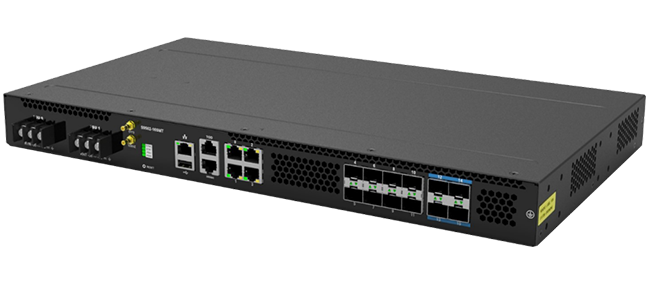
UfiSpace S9502-16SMT Fanless DCSG
Fanless DCSGs minimizes the amount of moving parts within the disaggregated cell site gateways to further reduce the likelihood of mechanical failures. Instead of relying on mechanical fans, which draws more power and is susceptible to wear and tear, the DCSG utilizes heatsinks to draw the heat from the components and dissipates heat using natural airflow.
DCSG Software Features
One of the major benefits of DCSGs for service providers is the choice to choose the software features they want running on top of the cell site gateway. Since the inception of DCSG in 2018, the software vendor ecosystem has grown exponentially to encompass world renowned solution providers like IP Infusion, Capgemini Engineering, and ADVA.
New software features are also constantly being introduced, fueled by the innovative nature of an open networking ecosystem. It is very much in line with what service providers had hoped when they first begin disaggregating the cell site gateway.
Here are some of the software features for the DCSG according to the Telecom Infra Project:
• OSPFv2 (RFC 2328)
• OSPFv3 for scenarios where IPv6 is used (RFC 5340)
• eBGP for CE to PE communication
• OSPFv2/v3 for CE to PE communication
• IS-IS for IPv4
• IS-IS for IPv4 and IPv6 compatible mapping
• IS-IS ready for supporting IPv6 and IPv4/IPv6 dual stack
• MACSec support
• Support off EAP-TLS IEEE 802.1x where MACsec is not implemented
• MD5 support for mutual authentication with other NEs/DCSGs
The DCSG would include Netconf (RFC 7803) and PCEP interfaces for compatibility with software defined networking (SDN) controllers. In addition, for advanced monitoring and telemetry features, the DCSG would support gRPC Network Management Interface (gNMI), gPB (Google Protocol Buffers) proto3 for encoding, and data exported (modelling) based on YANG models.
DCSG Use cases
As seen with AT&T and Asia Pacific Telecom, the main use case for DCSG would be to perform 2G/3G/4G/5G backhaul for the mobile transport IP/MPLS network.
However, the open networking nature of the DCSG allows for several different backhaul applications to be implemented onto the same white box platform. Additional applications other than cell site aggregation for mobile backhaul includes:
• Indoor unit for Microwave Backhaul
• Provider Edge Router
• Fronthaul Aggregation with TSN support
• DCI & Regional Backhaul with OpenZR+ support
• Private 5G Networks
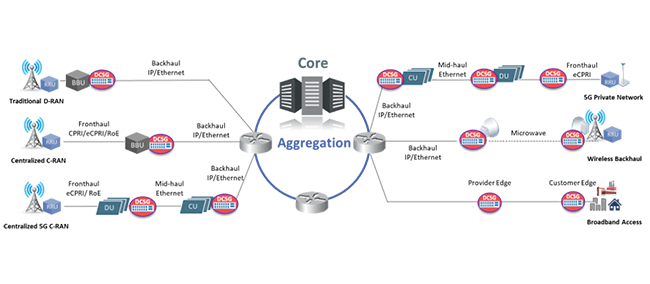
DCSG use cases in the telecom transport network
Where to Find DCSGs
The open and disaggregated feature means there will always be new vendors offering their version of the DCSG, but of course deployment experience and capabilities goes a long way. For those who are unsure where to find DCSG vendors, they can visit the marketplaces for Telecom Infra Project (TIP) and Open Compute Project (OCP). These are the two longest standing and largest ecosystems for disaggregated cell site gateways.
Click here to visit Telecom Infra Project’s marketplace.
Click here to visit Open Compute Project’s marketplace.
What are the DCSG Options?
Not every cell site is going to be the same. There will be different requirements for DCSGs depending on the cabinet spacing, power availability, climate, traffic and even services deployed. DCSGs options have to be versatile enough to fit the specific needs of the service provider. The chart below shows the different DCSG options available for different speeds, capacities and port densities.
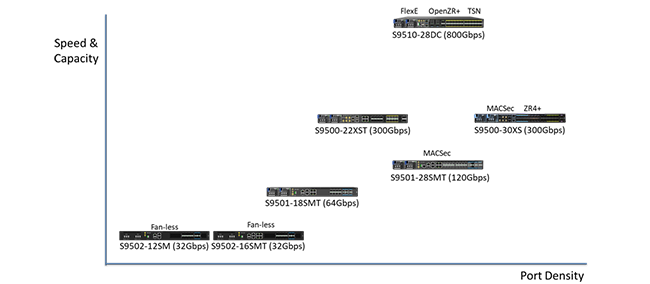
DCSG Options by Speed, Capacity and Port Density
UfiSpace offers field proven DCSGs in an variety of speed, capacity and port density options. If you would like to get samples of our DCSGs, please contact our sales team.

